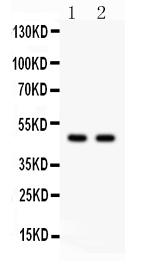Anti-PTOV1 Antibody
- SPECIFICATION
- CITATIONS
- PROTOCOLS
- BACKGROUND

Application
| WB |
|---|---|
| Primary Accession | Q86YD1 |
| Host | Rabbit |
| Reactivity | Human, Rat |
| Clonality | Polyclonal |
| Format | Lyophilized |
| Description | Rabbit IgG polyclonal antibody for Prostate tumor-overexpressed gene 1 protein(PTOV1) detection. Tested with WB in Human;Rat. |
| Reconstitution | Add 0.2ml of distilled water will yield a concentration of 500ug/ml. |
| Gene ID | 53635 |
|---|---|
| Other Names | Prostate tumor-overexpressed gene 1 protein, PTOV-1, Activator interaction domain-containing protein 2, PTOV1, ACID2 |
| Calculated MW | 46869 MW KDa |
| Application Details | Western blot, 0.1-0.5 µg/ml, Rat, Human |
| Subcellular Localization | Cell membrane. Cytoplasm, perinuclear region. Nucleus. Translocates from the cytoplasm to the nucleus at the onset of S-phase. Also localizes to lipid rafts. |
| Tissue Specificity | Expressed in brain, heart, kidney, liver, placenta, skeletal muscle and small intestine. . |
| Protein Name | Prostate tumor-overexpressed gene 1 protein |
| Contents | Each vial contains 5mg BSA, 0.9mg NaCl, 0.2mg Na2HPO4, 0.05mg NaN3. |
| Immunogen | A synthetic peptide corresponding to a sequence at the C-terminus of human PTOV1 (385-414aa NFVNGIRRVIANQQQVLQRNLEQEQQQRGM), different from the related mouse and rat sequences by one amino acid. |
| Purification | Immunogen affinity purified. |
| Cross Reactivity | No cross reactivity with other proteins |
| Storage | At -20˚C for one year. After r˚Constitution, at 4˚C for one month. It˚Can also be aliquotted and stored frozen at -20˚C for a longer time.Avoid repeated freezing and thawing. |
| Sequence Similarities | Belongs to the Mediator complex subunit 25 family. PTOV1 subfamily. |
| Name | PTOV1 |
|---|---|
| Synonyms | ACID2 |
| Function | May activate transcription. Required for nuclear translocation of FLOT1. Promotes cell proliferation. |
| Cellular Location | Cytoplasm. Nucleus. Cell membrane. Cytoplasm, perinuclear region. Note=Translocates from the cytoplasm to the nucleus at the onset of S-phase (PubMed:12598323). Also localizes to lipid rafts (PubMed:15713644). |
| Tissue Location | Expressed in brain, heart, kidney, liver, placenta, skeletal muscle and small intestine. |

Thousands of laboratories across the world have published research that depended on the performance of antibodies from Abcepta to advance their research. Check out links to articles that cite our products in major peer-reviewed journals, organized by research category.
info@abcepta.com, and receive a free "I Love Antibodies" mug.
Provided below are standard protocols that you may find useful for product applications.
Background
Prostate tumor overexpressed gene 1 protein is a protein that in humans is encoded by the PTOV1 gene. It is mapped to 19q13.33. This gene encodes a protein that was found to be overexpressed in prostate adenocarcinomas. The encoded protein was found to interact with the lipid raft protein flotillin-1 and shuttle it from the cytoplasm to the nucleus in a cell cycle dependent manner. Alternative splicing of this gene results in multiple transcript variants.
If you have used an Abcepta product and would like to share how it has performed, please click on the "Submit Review" button and provide the requested information. Our staff will examine and post your review and contact you if needed.
If you have any additional inquiries please email technical services at tech@abcepta.com.













 Foundational characteristics of cancer include proliferation, angiogenesis, migration, evasion of apoptosis, and cellular immortality. Find key markers for these cellular processes and antibodies to detect them.
Foundational characteristics of cancer include proliferation, angiogenesis, migration, evasion of apoptosis, and cellular immortality. Find key markers for these cellular processes and antibodies to detect them. The SUMOplot™ Analysis Program predicts and scores sumoylation sites in your protein. SUMOylation is a post-translational modification involved in various cellular processes, such as nuclear-cytosolic transport, transcriptional regulation, apoptosis, protein stability, response to stress, and progression through the cell cycle.
The SUMOplot™ Analysis Program predicts and scores sumoylation sites in your protein. SUMOylation is a post-translational modification involved in various cellular processes, such as nuclear-cytosolic transport, transcriptional regulation, apoptosis, protein stability, response to stress, and progression through the cell cycle. The Autophagy Receptor Motif Plotter predicts and scores autophagy receptor binding sites in your protein. Identifying proteins connected to this pathway is critical to understanding the role of autophagy in physiological as well as pathological processes such as development, differentiation, neurodegenerative diseases, stress, infection, and cancer.
The Autophagy Receptor Motif Plotter predicts and scores autophagy receptor binding sites in your protein. Identifying proteins connected to this pathway is critical to understanding the role of autophagy in physiological as well as pathological processes such as development, differentiation, neurodegenerative diseases, stress, infection, and cancer.


